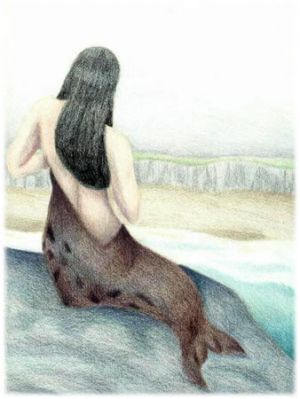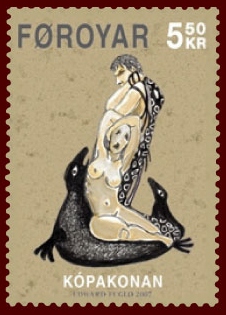A selkie (also known as silkie or selchie) is a shapeshifter creature in Faroese, Irish, Icelandic, and Scottish mythology.
Etymology
The legend apparently originated on the Orkney Islands, where selch or selk(ie) is the Scots word for seal (from Old English seolh).
Place
They can be found near the islands of Orkney and Shetland.
Description
Selkies are able to transform to human form by shedding their seal skins and can revert to seal form by putting their selkie skin back on. When in human form, both sex are described as handsome and seductive.Male selkies typically seek those who are dissatisfied with their romantic life. This includes married women waiting for their fishermen husbands.
Powers
- The male Selkies are responsible for storms and also for the sinking of ships, which is their way of avenging the hunting of seals.
- A selkie can only make contact with one particular human for a short amount of time before they must return to the sea. They are not able to make contact with that human again for seven years, unless the human is to steal their selkie's skin and hide it or burn it. Examples of such stories are The Grey Selkie of Suleskerry, a ballad, and the movie The Secret of Roan Inish.
- If a woman wishes to make contact with a selkie male, she has to go to a beach and shed seven tears into the sea.
- If a man steals a female selkie's skin, she is in his power, to an extent, and she is forced to become his wife (a regional variant on the motif of the swan maiden, unusual in that the bride's animal form is usually a bird). Female selkies are said to make excellent wives, but because their true home is the sea, they will often be seen gazing longingly to the ocean. If her skin is found she will immediately return to her home — sometimes, her selkie husband — in the sea.
Stories
Stories concerning selkies are generally romantic tragedies. Sometimes the human will not know that their lover is a selkie, and wakes to find them gone. Other times the human will hide the selkie's skin, thus preventing them from returning to seal form.
- In The Secret of Roan Inish, a fisherman steals the selkie's pelt while she is sunbathing. She then returns to his house and becomes his wife and bears him children. He stashes away her skin and years later, one of the children mentions it and asks what it is. The wife immediately drops what she's doing, retrieves the pelt and returns to her former life as a seal.
- Sometimes, a selkie maiden is taken as a wife by a human man and she has several children by him. In these stories, it is one of her children who discovers her sealskin (often unwitting of its significance) and she soon returns to the sea. The selkie woman avoids seeing her human husband again but is sometimes shown visiting her children and playing with them in the waves.
- Selkies are not always faithless lovers. One tale tells of the fisherman Cagan who married a seal-woman. Against his wife's wishes he set sail dangerously late in the year, and was trapped battling a terrible storm, unable to return home. His wife shifted to her seal form and saved him, even though this meant she could never return to her human body and hence her happy home.
- The selkie legend is also told in Wales, but in a slightly different form. The selkies are humans who have returned to the sea. Dylan (Dylan Eil Don) the firstborn of Arianrhod, was variously a merman or sea spirit, who in some versions of the story escapes to the sea immediately after birth.
- Some stories from Shetland have selkies luring islanders into the sea at midsummer, the lovelorn humans never returning to dry land.
Theories
- One folklorist theory of the origin of the belief is that the selkies were actually fur-clad Finns, traveling by kayak.[2] As the anthropologist A. Asbjorn Jon has recognised though, there is a strong body of lore that indicates that selkies 'are said to be supernaturally formed from the souls of drowned people'.[3]
- Seal changelings similar to the selkie exist in the folklore of many cultures. A corresponding creature existed in Swedish legend, and the Chinook Indians of North America have a similar tale of a boy who changes into a seal (see the children's story The Boy Who Lived With The Seals by Rafe Martin).
Popular culture
- Jane Yolen incorporated such a changeling as a selkie into her picture book, Greyling.
- One of the main supporting characters in Jane Johnson's Eidolon trilogy is a young girl selkie called She Who Swims the Silver Path of The Moon (Silver for short) who becomes close with the main hero, Ben Arnold, when he rescues her from the evil Doddman's pet shop.
- Seal Child is a children's novel by Sylvia Peck which details a modern telling of the selkie myth. The Folk Keeper, a "young readers" novel by Franny Billingsley CACA also uses this myth powerfully. The recent album "Honeycomb" by Pixies front-man Frank Black includes a tune called "Selkie Bride", which alludes to the Selkie legend. At least one tale about selkies is included in Scottish Folk Tales by Ruth Manning-Sanders. Terry Farley, known for her books about horses that are written for children, broke from that style to write "Seven Tears into the Sea" a modern and slightly differnt selkie tale for teenagers.
- The science-fiction Petaybee Series by Anne McCaffrey and Elizabeth Ann Scarborough employs the selkie myth in a futuristic setting. Selkies also appear as one of many varieties of "changed" human in both John Ringo's Council Wars series and Ken MacLeod's Engines of Light trilogy.
- The video game Final Fantasy: Crystal Chronicles features selkies as a race. Unlike mythical selkies, the ones in Final Fantasy: Crystal Chronicles are simply a human race, with body paint, such as stripes, or arrows on even the youngest children in the game. The selkies in the game usually have blue-green hair, probably referring to the mythical selkie's origin in the sea. One reference to them, however, is in their town, there is a selkie who says something along the lines of, "We Selkies came from the sea, and one day we will return there."
- The folk musician Mike Agranoff wrote a song entitled "The Ballad of the White Seal Maid", that is a sad story of a fisherman and his selkie wife.
- The book "Water Shaper" is based on some myths about selkies.
- The song "Sælkvinden" (the seal-woman) by Danish singer Lars Lilholt is a sad story about a young fisherman and a selkie.
- British fantasy author Susan Cooper has written both a picture book and a novel featuring selkies. The picture book, Selkie Girl, recounts a traditional selkie legend from Ireland. The novel, Seaward, features characters who turn out to be selkies.
- J.K. Rowling included selkies in the Harry Potter series. They appeared in The Goblet of Fire and The Half-Blood Prince. They are classified as a species of merpeople who have grey skin, wild green hair, yellow eyes and wear bones and teeth around their necks. They live in the lake in the school grounds and when above the water, they speak a screechy language called Mermish.
- In the first Meredith Gentry novel, A Kiss of Shadows, by Laurell K. Hamilton, a selkie named Roane Finn is the lover of Merry Gentry, who is a part human part fey princess who is hiding in Los Angeles in self-imposed exile from the Unseelie Kingdom due to political plots against her. Merry and Finn are both paranormal detectives working for the Grey Detective Agency. Finn had been trapped in human form when a fisherman had found his seal skin and burned it. When the latent magic in Merry is awakened, it first manifests itself by miraculously regenerating Finn's shapeshifting ability. He immediately returns to his life in the sea for which he had been pining.
- George Mackay Brown's novel Beside the Ocean of Time also involves a young man falling love with a Selkie, and the hiding of her sealskin to keep her from returning to the sea.
- The 1994 John Sayles movie, The Secret of Roan Inish, tells the story of a family descended from selkies. It is based on the novel The Secret of Ron Mor Skerry by Rosalie K. Fry.
- In an episode of Catscratch, the banshee that was haunting the Highland Quid Clan was in fact a selkie (called a "seal woman" in the show) under a curse. Gordon freed the selkie by vocalizing in high tones and pitches.
- In 1998, American author Christina Dodd published a romance novel entitled A Well Favored Gentleman about Ian Fairchild. His character made his first appearance in the first book of the Well Pleasured series, A Well Pleasured Lady (1997). Ian is the son of a selkie and has powers due to that legacy.
- Terri Farley published a book in 2005 called "Seven Tears into the Sea". It is a teen romance novel following the story of a young girl who returns to her hometown in search of a selkie she encountered seven years ealier.
- In Tom Clancy's 1998 novel "Net Force," a female assassin uses the name "The Selkie" as her underground cover name. In the novel, she is of Irish heritage.
- In Anne Bishops Tir Alainne trilogy selkies are a member of the Fae race who must help witches avoid the mass murdering black inquisitors in order to stay alive.
- Juliet Marillier wrote several trilogies, mixing folklore with history. In Child of the Prophecy (2001) Darragh is turned into a selkie by the Fae, while Watcher in Foxmask (2003) is a descendant of a selkie mother and a human father.
- The melodic progressive metal band Between the Buried and Me released their Alaska album in 2005 with a song called "Selkies: The Endless Obsession."
Bibliography
- . ^ Hardie, Alison (20.01.2007) Dramatic decline in island common seal populations baffles experts - Mystical Connections. The Scotsman newspaper.
- . ^ Carole B. Silver, Strange and Secret Peoples: Fairies and Victorian Consciousness, p 47 ISBN 0-19-512199-6
- . ^ A. Asbjorn Jon, 'Dugongs and Mermaids, Selkies and Seals', in Australian Folklore (13, 1998), pp.94-98 (p.96) http://www.une.edu.au/folklorejournal/ ISBN 1-86389-543-4
- Thomson, David The People of the Sea: A Journey in Search of the Seal Legend
- Katharine Briggs, An Encyclopeidia of Fairies, Hobgoblins, Brownies, Boogies, and Other Supernatural Creatures, ISBN 0-394-73467-X
See also
- Kelpies
- Merrow
- Muc-sheilch (cognate with selkie)
- Dobhar-chu
- Lavellan
External links
- The Selkie Folk, from Orkneyjar, "a website dedicated to the preserving, exploring and documenting the ancient history, folklore and traditions of Orkney."
- Annotated Selkie resources from Mermaids on the Web
- The Origin of the Selkie Folk from Orkneyjar
- A Home for Selkies by Beth Winegarner
- Legend of the Selkie Soldier
- A painting of a Selkie by Kentucky artist Daniel Dutton


